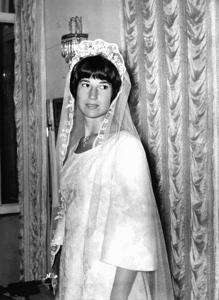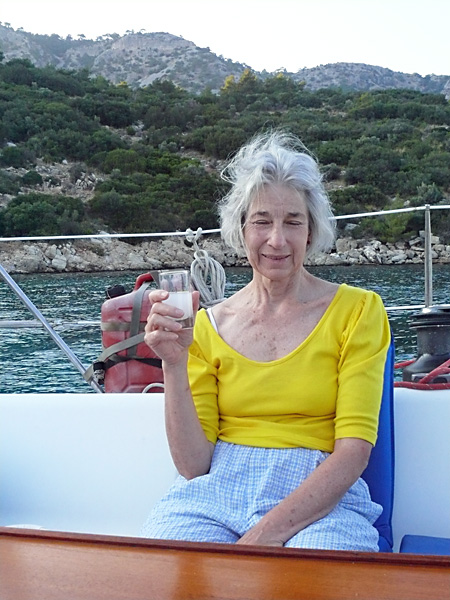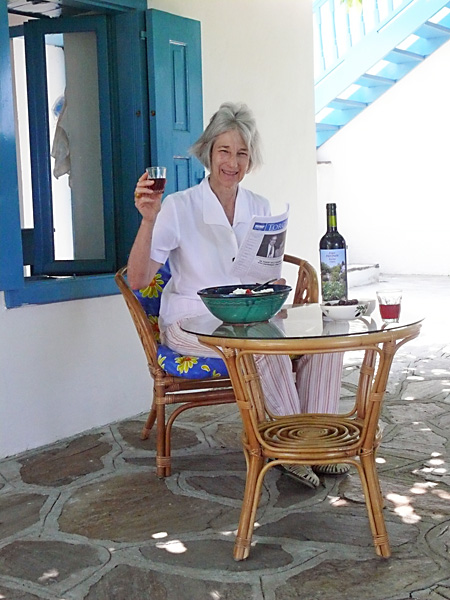
Alice Swift Riginos was born in May 27, 1941 to a prominent Chicago family.
She was a remarkable person totally noncompetitive, competing only with herself. She did not try to impress or surpass anyone else. All she wanted was to be, in what she undertook, so good that she herself was satisfied. In her professional life, she did not produce volumes, but what she did produce was always close to perfection. I, Vasilis Riginos, was very lucky to meet her on an ocean liner in 1964 and we ended up spending our lives together.
Alice was involved the IWMF Torch, for which she served as its editor for 10 years. The Torch is the monthly news magazine of IMMF the organization of the sufferers of the very rare blood cancer of Waldenström's Macroglobulinemia. During her time as its editor she brought many improvements to the Torch and transformed it into a polished and diverse newsletter.
Alice’s father was an archaeologist who excavated in Greece and later, for many seasons, in Sardis, Turkey. Teenager Alice helped her father as a cataloger in the 1961-62 Sardis seasons. This was her first taste of archaeology.
After graduating from the University of Chicago Lab School she enrolled in Stanford University as a pre-medical student. But she decided to leave after her first year and go to the University of Chicago. She graduated in 1963 with a B.A. in Ancient History.
In 1964 she was awarded a traveling fellowship to the prestigious American School of Classical Studies at Athens, Greece. Since she was planning to continue with the Kenchreai, Corinth excavation in the summers she boarded the Ocean Liner Queen Frederica sailing from New York to Piraeus, Greece. It was on this passage that we first met. We had a shipboard romance which continued through the summer. At the end of the summer, I returned to the U.S. and continued my studies in Stevens Institute of Technology in New Jersey. During the summer of 1965 Alice did archaeological field work at the Ancient Corinth American School excavation.
The plan for the 1966 season excavation at Kenchreai was to expand the land work to underwater excavation. To that end, during the spring Alice took diving lessons in Chicago and then joined the excavation as a diver/archaeologist. The underwater excavation site was not very deep, about 10 meters (34 ft), so the scuba tanks allowed a diver to spend about 2 hours underwater as there was no need for decompression. The clearing of the sand and mud was done by a contraption called “air-lift.” It is a long and fairly wide metal tube its top buoyed on the surface and its bottom, guided by a diver, air is fed at its bottom by an air compressor hose. The air-lift sucks the derby and empties it at the surface after a wide filter that catches any small objects. Large objects, such as pottery, are not sucked but the divers places them in rubber bags. These bags are suspended from a large plastic bag full of air inside. When a rubber bag is full more air is added to its plastic bag and it then rises to the surface and is then retrieved by the diving boat.
Aliki typically made at least 2 dives every day and was the only diver who did not wear wet-suit pants. She did not like them because they impeded her movements.

In the August of 1967 after a long romance Alice and I were married in Athens. I was completing my mandatory service in the Greek army as a 2nd lieutenant. We lived in Athens during the very difficult Junta (military dictatorship) years util the spring of 1968 when I was at last released from the army.
In the summer of 1968 Alice returned to the Kenchreai to direct the underwater excavation and she hired me as a diver. It was fun but hard work. After the excavation was over we took a boat to New York to continue our studies: Alice in classical studies (Greek and Latin) at Columbia University and I in electrical engineering at the Stevens Institute of Technology in New Jersey.
On April 3, 1971, our daughter Cynthia was born in New York City. The care of baby Cynthia was split: I cared for Cynthia during the day when Alice did her research in the Columbia library, and in the evening Alice cared for her, after her return and I left for my laboratory and research in electrophysics. In 1973 I obtained his Ph.D. in Electrophysics from Stevens Institute of Technology.
In 1974 we moved from New York City to Washington, D.C. I became a member of the technical staff of COMSAT Laboratories and Alice took care of Cynthia while working on her book Platonica: the Anectdotes Concerning the Life and Writings of Plato. This book was based on her doctorate dissertation and examined biographical writing about Plato from antiquity to the early middle ages both in Europe and in the Arab world. The book was published in 1976 by Leiden E. J. Brill in their series of Columbia Studies in the Classical Tradition III, ISBN 978-9004045651. This book is viewed by classical scholars as a very influential work. Alice was awarded her Ph.D. from the Department of Greek and Latin, Columbia University for this work.
In 1975 Alice was hired as a lecturer by Howard University in Washington, D.C. In August 5, 1978, our daughter Corinna was born. Alice rose to an associate professor and continued to teach at Howard until her retirement in 2004. During her tenure she taught Classical Greek and Latin and a very popular course in Classical Mythology. She mentored many undergraduate students from several departments. Some of these went on to graduate school and stayed in touch with Alice seeking her advice on academic and personal issues. On several holidays there was either a current or an ex-student having dinner in our house.
Alice was also very active in the local DC chapter of the American Institute of Archaeology (AIA), including four years as its president. Over the years, she applied her usual energy and upgraded the society in various ways. Following her president’s tenure she served in various committees. From 1992 to 1996 she was in the regional symposia committee and from 1999 to 2005 she chaired this committee. In 1966 she became a life member of the national AIA, its ombudsperson in 2001, and a national trustee in 1995 to 2005.
In 1994 she published a major article in the Journal of Hellenic Studies, Vol 114, pages 103-119, titled The Wounding of Philip II of Macedon: Fact and Fabrication. This was the result of many years of research and chronicled the textual evidence both supporting and disputing claims that a rich tomb discovered in 1977 belonged to King Philip.
She was a member of several professional societies: the American Philological Association, Institute of Nautical Archaeology, the Hellenic Institute of Marine Archaeology, the Classical Association of the Atlantic States, the Washington Classical Society, and she was an honorary member of Eta Sigma Phi.
In the fall of 2002 during Alice's routine medical checkup her internist noticed that she had a slight anemia. During her 2003 checkup the anemia was still there and her internist referred her to a hematologist/oncologist Dr. Bruce Kressel. He performed a bone marrow biopsy which confirmed Waldenström's Macroglobulinemia (WM). She also had a very elevated IgM. This diagnosis was fortunate because many WM patients can be years in and out of doctors offices before they get a definitive diagnosis.

We decided to get a second opinion and also started researching the published literature on WM. We went to John’s Hopkins in Baltimore. The hematologist there suggested an aggressive chemotherapy treatment. We then decided to consult with Dr. Morie A. Gertz of Mayo Clinic in Minnesota. When we informed Dr. Kressel of this he told us that he himself had already consulted Dr. Gertz by phone. Following a trip to Mayo and meeting with Dr. Gertz, Alice embarked on a treatment with Rituximab, a monoclonal antibody not a chemotherapy agent. This reduced somewhat her IgM. The advice was to wait for a while and see.
At that time, early 2004 she joined IWMF and followed its talk lists. In the next 16 years she had several chemotherapy treatments, of increasing aggression, always combined with Rituximab. At one time her IgM exceeded 10,000 (normal is under 200). The pattern was: treatment and a period of 2-3 years of tolerable IgM which allowed her to travel to Greece, Australia, and India. Then she had another chemotherapy course and the pattern repeated.
During this time she became very active in IWMF becoming the editor of their monthly publication, the Torch from 2008 to 2018. She worked very hard on every issue, often while traveling to our summer home in Greece or to visit our children and our three grandchildren.

In 2017 she had a treatment of Rituximab combined with Bortezomib (Valcade), and Dexamethasone. Half way through the treatment she had a strong allergic reaction to Valcade. The dosage was halved and she completed the treatment. The results on her IgM were dramatic: it was almost non detectable. But her immune system was severely compromised and she developed a series of infections: herpes zoster (shingles) on her head, erythema nodosum on her legs, and finally in the fall of 2019 the common JC (Human polyomavirus 2) virus penetrated her brain and caused PML (progressive multifocal leukoencephalopathy) which is incurable. This caused severe mental and locomotion problems.
Alice Swift Riginos died peacefully in her bed at 8:30 AM on December 30, 2019. She was attended by her husband Vasilis Riginos, and her daughters Cynthia and Corinna Riginos. I miss her dearly and remember fondly our many adventures together and her tremendous dedication to the many causes to which she devoted herself.